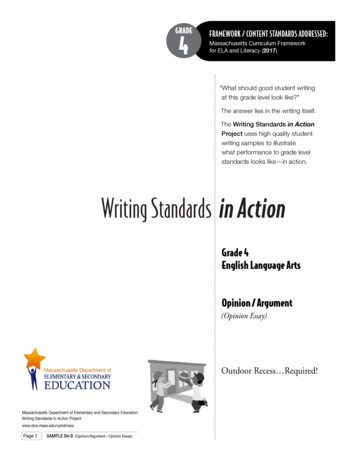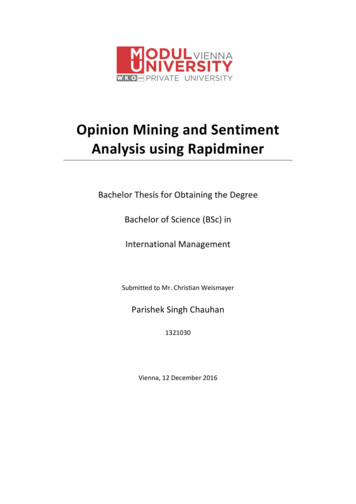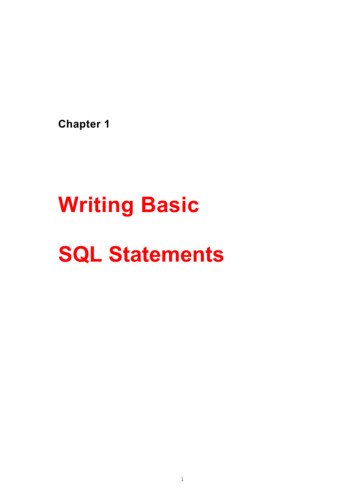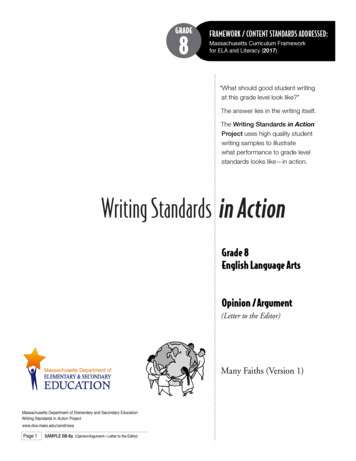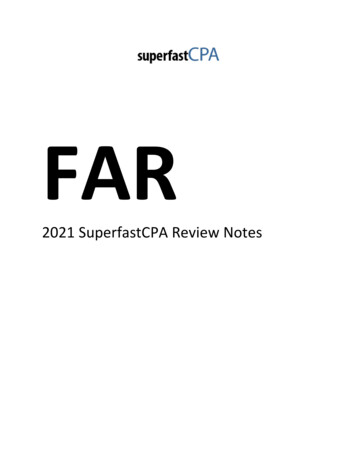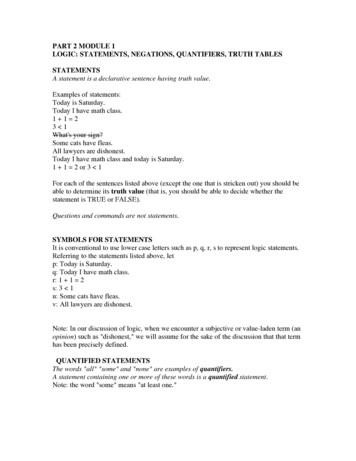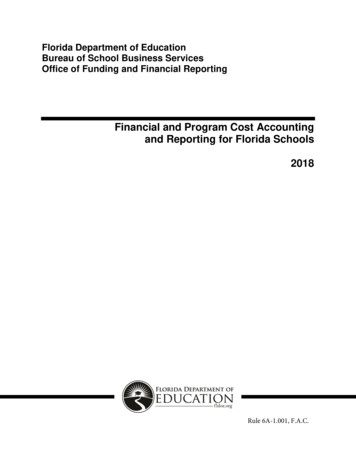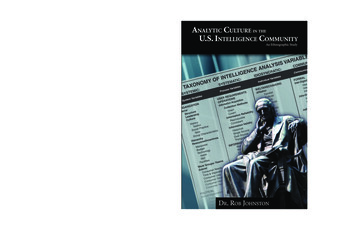
Transcription
All statements of fact, opinion, or analysis expressed in this bookare those of the authors. They do not necessarily reflect officialpositions of the Central Intelligence Agency or any other US government entity, past or present. Nothing in the contents should beconstrued as asserting or implying US government endorsementof the authors’ factual statements and interpretations.The Center for the Study of IntelligenceThe Center for the Study of Intelligence (CSI) was founded in 1974 inresponse to Director of Central Intelligence James Schlesinger’s desire to create within CIA an organization that could “think through the functions ofintelligence and bring the best intellects available to bear on intelligence problems.” The Center, comprising professional historians and experienced practitioners, attempts to document lessons learned from past operations, explorethe needs and expectations of intelligence consumers, and stimulate seriousdebate on current and future intelligence challenges.To support these activities, CSI publishes Studies in Intelligence and booksand monographs addressing historical, operational, doctrinal, and theoreticalaspects of the intelligence profession. It also administers the CIA Museumand maintains the Agency’s Historical Intelligence Collection.Comments and questions may be addressed to:Center for the Study of IntelligenceCentral Intelligence AgencyWashington, DC 20505Printed copies of this book are available to requesters outside theUS government from:Government Printing Office (GPO)Superintendent of DocumentsP.O. Box 391954Pittsburgh, PA 15250-7954Phone: (202) 512-1800E-mail: orders@gpo.govISBN: 1-929667-13-2
ANALYTIC CULTURE IN THE USINTELLIGENCE COMMUNITY
The Center for the Study of IntelligenceCentral Intelligence AgencyWashington, DC 20505Library of Congress Cataloguing-in-Publication dataJohnston, RobAnalytic Culture in the US Intelligence Community: An Ethnographic Study/Dr. Rob JohnstonIncludes bibliographic references.ISBN 1-929667-13-2 (pbk.:alk paper)1. Intelligence—United States. 2. Intelligence analysis.3. Intelligence policy. 4. Intelligence training.Typeset in Times and Ariel.Printed by Imaging and Publication Support, CIA.Cover design: Imaging and Publication Support, CIA.The pensive subject of the statue is Karl Ernst von Baer (1792–1876), thePrussian-Estonian pioneer of embryology, geography, ethnology, and physicalanthropology (Jane M. Oppenheimer, Encyclopedia Brittanica).
ANALYTIC CULTURE IN THEUS INTELLIGENCE COMMUNITYAN ETHNOGRAPHIC STUDYDR. ROB JOHNSTONCenter for the Study of IntelligenceCentral Intelligence AgencyWashington, DC2005
ACKNOWLEDGEMENTSThere are literally slightly more than 1,000 people to thank for their help indeveloping this work. Most of them I cannot name, for one reason or another,but my thanks go out to all of those who took the time to participate in thisresearch project. Thank you for your trust. Particular thanks are due the otherresearchers who coauthored chapters: Judith Meister Johnston, J. DexterFletcher, and Stephen Konya.There is a long list of individuals and institutions deserving of my gratitude,but, at the outset, for making this study possible, I would like to express myappreciation to Paul Johnson and Woody Kuhns, the chief and deputy chief ofthe Central Intelligence Agency’s Center for the Study of Intelligence, andtheir staff for their support and to John Phillips and Tom Kennedy of the Intelligence Technology Innovation Center who, along with their staff, administerthe Director of Central Intelligence Postdoctoral Fellowship Program.I would like to thank Greg Treverton and Joe Hayes for their help throughout this project and for their willingness to give of their time. Dr. ForrestFrank, Charles Perrow, and Matthew Johnson deserve recognition for thematerial they contributed. Although it was not possible to cite them as references for those contributions, these are indicated in the footnotes, and I givethem full credit for their work and efforts.I would also like to thank Bruce Berkowitz, Mike Warner, Fritz Ermarth,Gordon Oehler, Jeffrey Cooper, Dave Kaplan, John Morrison, James Wirtz,Robyn Dawes, Chris Johnson, Marilyn Peterson, Drew Cukor, DennisMcBride, Paul Chatelier, Stephen Marrin, Randy Good, Brian Hearing, PhilWilliams, Jonathan Clemente, Jim Wilson, Dennis, Kowal, Randy Murch,Gordie Boezer, Steve Holder, Joel Resnick, Mark Stout, Mike Vlahos, MikeRigdon, Jim Silk, Karl Lowe, Kevin O’Connell, Dennis Gormley, RandyPherson, Chris Andrew, Daniel Serfaty, Tom Armour, Gary Klein, BrianMoon, Richard Hackman, Charlie Kisner, Matt McKnight, Joe Rosen, MikeYared, Jen Lucas, Dick Heuer, Robert Jervis, Pam Harbourne, Katie Dorr,v
Dori Akerman, and, most particularly, my editors: Mike Schneider, AndyVaart, and Barbara Pace. Special thanks are also due Adm. Dennis Blair, USN(Ret.), and Gen. Larry Welch, USAF (Ret.), and their staff.There were 50 peer reviewers who made sure I did not go too far afield inmy research and analysis. Again, there are mitigating reasons why I cannotthank them by name. Suffice it to say, their work and their time were invaluable, and I appreciate their efforts.Because I cannot name specific individuals, I would like to thank the organizations of the Intelligence Community that gave me access to perform this researchand made available research participants: Air Force Intelligence; Army Intelligence; Central Intelligence Agency; Defense Intelligence Agency; Department ofEnergy; Department of Homeland Security; Bureau of Intelligence and Research,Department of State; Department of the Treasury; Federal Bureau of Investigation; Marine Corps Intelligence; National Geospatial Intelligence Agency;National Reconnaissance Office; National Security Agency; Navy Intelligence.Thanks are also due the following: Institute for Defense Analyses; the Sherman Kent Center and the Global Futures Partnership at the CIA University; theCIA’s Publications Review Board; Office of Public Affairs, National Archives;Joint Military Intelligence College; Advanced Research and Development Activity, Defense Advanced Research Projects Agency (DARPA); International Association of Law Enforcement Intelligence Analysts; Drug EnforcementAdministration and the DEA Academy; FBI Academy; National Military Intelligence Association; Association of Former Intelligence Officers; MITRE; RAND;Analytic Services, Inc. (ANSER); Potomac Institute; Center for Strategic andInternational Studies; Woodrow Wilson International Center; Booz Allen Hamilton; Naval Postgraduate School; Columbia University; Dartmouth College; University of Pittsburgh; Georgetown University; Carnegie Mellon University;Cambridge University; Johns Hopkins University and the Advanced PhysicsLaboratory; George Mason University; Harvard University; Yale University;American Anthropological Association; Society for the Anthropology of Work;Society for Applied Anthropology; National Association for the Practice ofAnthropology; Inter-University Seminar on Armed Forces and Society; RoyalAnthropological Institute, and the national laboratories.I express my sincere apologies if I have failed to include any individuals ororganizations to which thanks are due. Moreover, any errors of commission oromission are my own. God knows, with this much help, there is no one toblame but myself. Mostly, though, I would like to thank my long-sufferingwife, to whom this book is dedicated. Thanks, Jude.vi
CONTENTSForeword by Gregory F. Treverton . xiIntroduction . xiiiBackground . xivScope . xviiA Work in Progress . xixPart I: Research FindingsChapter One: Definitions . 3Chapter Two: Findings. 9The Problem of Bias . 10Finding: Secrecy Versus Efficacy . 11Finding: Time Constraints . 13Finding: Focus on Current Production . 15Finding: Rewards and Incentives . 16Finding: “Tradecraft” Versus Scientific Methodology . 17Finding: Confirmation Bias, Norms, and Taboos . 21Finding: Analytic Identity . 25Finding: Analytic Training . 28Part II: Ethnography of AnalysisChapter Three: A Taxonomy of Intelligence Variables . 33Intelligence Analysis . 34Developing the Taxonomy . 37Systemic Variables . 39Systematic Variables . 40Idiosyncratic Variables . 41Communicative Variables . 42Conclusion . 43Chapter Four: Testing the Intelligence CycleThrough Systems Modeling and Simulation . 45The Traditional Intelligence Cycle . 45Systematic Analysis . 47Findings Based on Systematic Analysis . 47Systemic Analysis . 50vii
Findings Based on Systems Analysis .54Recommendations .55Part III: Potential Areas for ImprovementChapter Five: Integrating Methodologists into Teams of Experts .61Becoming an Expert .61The Power of Expertise .63The Paradox of Expertise .64The Burden on Intelligence Analysts .66The Pros and Cons of Teams .68Can Technology Help? .71Analytic Methodologists .72Conclusion .72Chapter Six: The Question of Foreign Cultures:Combating Ethnocentrism in Intelligence Analysis .75Case Study One: Tiananmen Square .76Case Study Two: The Red Team .81Conclusion and Recommendations .84Chapter Seven: Instructional Technology:Effectiveness and Implications for the Intelligence Community .87Background .88Meta-analysis Demonstrates the Effectiveness ofInstructional Technology .90Current Research on Higher Cognitive Abilities .92Discussion .94Conclusion .96Chapter Eight: Organizational Culture:Anticipatory Socialization and Intelligence Analysts .97Organizational Socialization .98Anticipatory Socialization .99Consequences of Culture Mismatch .101Anticipatory Socialization in the Intelligence Community .102Conclusion and Recommendations .104Chapter Nine: Recommendations .107The First Step: Recognizing A Fundamental Problem .107Performance Improvement Infrastructure .108Infrastructure Requirements .108Research Programs .111The Importance of Access .115viii
Part IV: Notes on MethodologyChapter Ten: Survey Methodology . 119Methodology . 120Demographics . 124Chapter Eleven: Q-Sort Methodology . 127Chapter Twelve: The “File-Drawer” Problem andCalculation of Effect Size . 129Appendix: Selected Literature . 133Intelligence Tools and Techniques . 133Cognitive Processes and Intelligence . 134Tools and Techniques as Cognitive Processes . 134Intelligence Analysis as Individual Cognitive Process . 135Error . 135Language and Cognition . 136Bibliography. 139Published Sources . 139Web resources . 157Afterword by Joseph Hayes . 159The Author . 161ix
FOREWORDGregory F. TrevertonIt is a rare season when the intelligence story in the news concerns intelligence analysis, not secret operations abroad. The United States is having sucha season as it debates whether intelligence failed in the run-up to both September 11 and the second Iraq war, and so Rob Johnston’s wonderful book is perfectly timed to provide the back-story to those headlines. The CIA’s Centerfor the Study of Intelligence is to be commended for having the good sense tofind Johnston and the courage to support his work, even though his conclusions are not what many in the world of intelligence analysis would like tohear.He reaches those conclusions through the careful procedures of an anthropologist—conducting literally hundreds of interviews and observing and participating in dozens of work groups in intelligence analysis—and so theycannot easily be dismissed as mere opinion, still less as the bitter mutteringsof those who have lost out in the bureaucratic wars. His findings constitute notjust a strong indictment of the way American intelligence performs analysis,but also, and happily, a guide for how to do better.Johnston finds no baseline standard analytic method. Instead, the most common practice is to conduct limited brainstorming on the basis of previous analysis, thus producing a bias toward confirming earlier views. The validating ofdata is questionable—for instance, the Directorate of Operation’s (DO) “cleaning” of spy reports doesn’t permit testing of their validity—reinforcing the tendency to look for data that confirms, not refutes, prevailing hypotheses. Theprocess is risk averse, with considerable managerial conservatism. There ismuch more emphasis on avoiding error than on imagining surprises. The analytic process is driven by current intelligence, especially the CIA’s crown jewelanalytic product, the President’s Daily Brief (PDB), which might be caricaturedxi
as “CNN plus secrets.” Johnston doesn’t put it quite that way, but the Intelligence Community does more reporting than in-depth analysis.None of the analytic agencies knows much about the analytic techniques ofthe others. In all, there tends to be much more emphasis on writing and communication skills than on analytic methods. Training is driven more by thedruthers of individual analysts than by any strategic view of the agencies andwhat they need. Most training is on-the-job.Johnston identifies the needs for analysis of at least three different types ofconsumers—cops, spies, and soldiers. The needs of those consumers produceat least three distinct types of intelligence—investigative or operational, strategic, and tactical.The research suggests the need for serious study of analytic methods acrossall three, guided by professional methodologists. Analysts should have manymore opportunities to do fieldwork abroad. They should also move muchmore often across the agency “stovepipes” they now inhabit. These movements would give them a richer sense for how other agencies do analysis.Together, the analytic agencies should aim to create “communities of practice,” with mentoring, analytic practice groups, and various kinds of on-lineresources, including forums on methods and problem solving. These communities would be linked to a central repository of lessons learned, based onafter-action post-mortems and more formal reviews of strategic intelligenceproducts. These reviews should derive lessons for individuals and for teamsand should look at roots of errors and failures. Oral and written historieswould serve as other sources of wherewithal for lessons. These communitiescould also begin to reshape organizations, by rethinking organizationaldesigns, developing more formal socialization programs, testing group configurations for effectiveness, and doing the same for management and leadershippractices.The agenda Johnston suggests is a daunting one, but it finds echoes in thework of small, innovative groups across the Intelligence Community—groupsmore tolerated than sponsored by agency leaders. With the challenge workforce demographics poses for the Community—the “gray-green” age distribution, which means that large numbers of new analysts will lack mentors as oldhands retire—also comes the opportunity to refashion methods and organizations for doing intelligence analysis. When the finger-pointing in Washingtonsubsides, and the time for serious change arrives, there will be no better placeto start than with Rob Johnston’s fine book.xii
INTRODUCTIONIn August 2001, I accepted a Director of Central Intelligence postdoctoralresearch fellowship with the Center for the Study of Intelligence (CSI) at theCentral Intelligence Agency. The purpose of the fellowship, which was tobegin in September and last for two years, was to identify and describe conditions and variables that negatively affect intelligence analysis. During thattime, I was to investigate analytic culture, methodology, error, and failurewithin the Intelligence Community using an applied anthropological methodology that would include interviews (thus far, there have been 489), direct andparticipant observation, and focus groups.I began work on this project four days after the attack of 11 September, andits profound effect on the professionals in the Intelligence Community wasclearly apparent. As a whole, the people I interviewed and observed werepatriotic without pageantry or fanfare, intelligent, hard working, proud of theirprofession, and angry. They were angry about the attack and that the militantIslamic insurgency about which they had been warning policymakers foryears had murdered close to 3,000 people in the United States itself. Therewas also a sense of guilt that the attack had happened on their watch and thatthey had not been able to stop it.Having occurred under the dark shadow of that attack, this study has nocomparable baseline against which its results could be tested, and it is difficultto identify biases that might exist in these data as a result of 11 September. Insome ways, post-9/11 data may be questionable. For example, angry peoplemay have an ax to grind or an agenda to push and may not give the most reliable interviews. Yet, in other ways, post-9/11 data may be more accurate.When people become angry enough, they tend to blurt out the truth—or, atleast, their perception of the truth. The people I encountered were, in my judg-xiii
INTRODUCTIONment, very open and honest; and this, too, may be attributable to 9/11. In anycase, that event is now part of the culture of the Intelligence Community, andthat includes whatever consequences or biases resulted from it.BackgroundThe opportunity to do this research presented itself, at least in part, as aresult of my participation in a multiyear research program on medical errorand failure for the Defense Advanced Research Projects Agency (DARPA). 1The DARPA research focused on team and individual error in minimally invasive or laparoscopic surgical procedures. This research revealed that individual errors were cognitive rather than purely psychomotor or skill-based. Forexample, some surgeons had trouble navigating three-dimensional anatomicalspace using the existing laparoscopic technology, with the result that thesesurgeons would identify anatomical structures incorrectly and perform a surgical procedure on the wrong body part.Other individual errors were discovered during the DARPA studies, but, forthe most part, these were spatial navigation and recognition problems forwhich there were technological solutions. Team errors, unlike individualerrors, proved to be more challenging. The formal and informal hierarchicalstructures of operating rooms did not lend themselves to certain performanceinterventions. Generally, junior surgical staff and support personnel were notwilling to confront a senior staff member who was committing, or was aboutto commit, an error.The culture of the operating room, coupled with the social and career structure of the surgical profession, created barriers to certain kinds of communication. For a surgical resident to inform a senior surgeon in front of the entireoperating room staff that he was about to cut the wrong organ could result incareer “suicide.” Such a confrontation could have been perceived by thesenior surgeon as a form of mutiny against his authority and expertise and achallenge to the social order of the operating room. Although not universal,this taboo is much more common than surgeons would care to admit. Unlikeindividual errors, purely technological solutions were of little value in tryingto solve team errors in a surgical environment.The DARPA surgical research was followed up by a multiyear study ofindividual and team performance of astronauts at the National Aeronauticsand Space Administration’s (NASA) Johnson Space Center. Results of theNASA study, also sponsored by DARPA, were similar to the surgical studyRob Johnston, J. Dexter Fletcher and Sunil Bhoyrul, The Use of Virtual Reality to Measure Surgical Skill Levels.1xiv
INTRODUCTIONwith regard to team interactions. Although, on the face of it, teams of astronauts were composed of peers, a social distinction nevertheless existedbetween commander, pilots, and mission specialists.As with surgery, there was a disincentive for one team member to confrontor criticize another, even in the face of an impending error. Eighty percent ofthe current astronauts come from the military, which has very specific rulesregarding confrontations, dissent, and criticism. 2 In addition to the similaritiesin behavior arising from their common backgrounds, the “criticism” taboowas continually reinforced throughout the astronaut’s career. Virtually anynegative comment on an astronaut’s record was sufficient for him or her to beassigned to another crew, “washed out” of an upcoming mission and recycledthrough the training program, or, worse still, released from the space programaltogether.Taboos are social markers that prohibit specific behaviors in order to maintain and propagate an existing social structure. Generally, they are unwrittenrules not available to outside observers. Insiders, however, almost always perceive them simply as the way things are done, the natural social order of theorganization. To confront taboos is to confront the social structure of a cultureor organization.I mention the surgical and astronautical studies for a number of reasons.Each serves as background for the study of intelligence analysts. Astronautsand surgeons have very high performance standards and low error rates. 3 Bothstudies highlight other complex domains that are interested in improving theirown professional performance. Both studies reveal the need to employ a variety of research methods to deal with complicated issues, and they suggest thatthere are lessons to be learned from other domains. Perhaps the most tellingconnection is that, because lives are at stake, surgeons and astronauts experience tremendous internal and external social pressure to avoid failure. Thesame often holds for intelligence analysts.In addition, surgery and astronautics are highly selective and private disciplines. Although their work is not secret, both groups tend to be shielded fromthe outside world: surgeons for reasons of professional selection, training, andthe fiscal realities of malpractice liability; astronauts because their communityNational Aeronautics and Space Administration, Astronaut Fact Book.NASA has launched missions with the shuttle fleet 113 times since 1981 and has experiencedtwo catastrophic failures. It is probable that both of those were mechanical/engineering failuresand not the result of astronaut error. Surgical reporting methods vary from hospital to hospital,and it is often difficult to determine the specific causes of morbidity and mortality. One longitudinal study of all surgical procedures in one medical center puts the surgical error rates at that centerbetween 2.7 percent and 7.5 percent. See Hunter McGuire, Shelton Horsley, David Salter, et al.,“Measuring and Managing Quality of Surgery: Statistical vs. Incidental Approaches.”23xv
INTRODUCTIONis so small and the selection and training processes are so demanding. 4 Intelligence analysts share many of these organizational and professional circumstances.The Intelligence Community is relatively small, highly selective, andlargely shielded from public view. For its practitioners, intelligence work is acognitively-demanding and high-risk profession that can lead to public policythat strengthens the nation or puts it at greater risk. Because the consequencesof failure are so great, intelligence professionals continually feel significantinternal and external pressure to avoid it. One consequence of this pressure isthat there has been a long-standing bureaucratic resistance to putting in place asystematic program for improving analytical performance. According to71 percent of the people I interviewed, however, that resistance has diminished significantly since September 2001.It is not difficult to understand the historical resistance to implementingsuch a performance improvement program. Simply put, a program explicitlydesigned to improve human performance implies that human performanceneeds improving, an allegation that risks considerable political and institutional resistance. Not only does performance improvement imply that the system is not optimal, the necessary scrutiny of practice and performance wouldrequire examining sources and methods in detail throughout the IntelligenceCommunity. Although this scrutiny would be wholly internal to the community, the concept runs counter to a culture of secrecy and compartmentalization.The conflict between secrecy, a necessary condition for intelligence, andopenness, a necessary condition for performance improvement, was a recurring theme I observed during this research. Any organization that requiressecrecy to perform its duties will struggle with and often reject openness, evenat the expense of efficacy. Despite this, and to their credit, a number of smallgroups within the Intelligence Community have tasked themselves with creating formal and informal ties with the nation’s academic, non-profit, and industrial communities. In addition, there has been an appreciable increase in theuse of alternative analyses and open-source materials.These efforts alone may not be sufficient to alter the historical culture ofsecrecy, but they do reinforce the idea that the Intelligence Community itselfhas a responsibility to reconsider the relationship between secrecy, openness,and efficacy. This is especially true as it relates to the community’s performance and the occurrence of errors and failure. External oversight and publicdebate will not solve these issues; the desire to improve the Intelligence Com-There are curre
aspects of the intelligence profession. It also administers the CIA Museum and maintains the Agency’s Historical Intelligence Collection. Comments and questions may be addressed to: Center for the Study of Intelligence Central Intelligence Agency Washington, DC 20505 . Printed co
